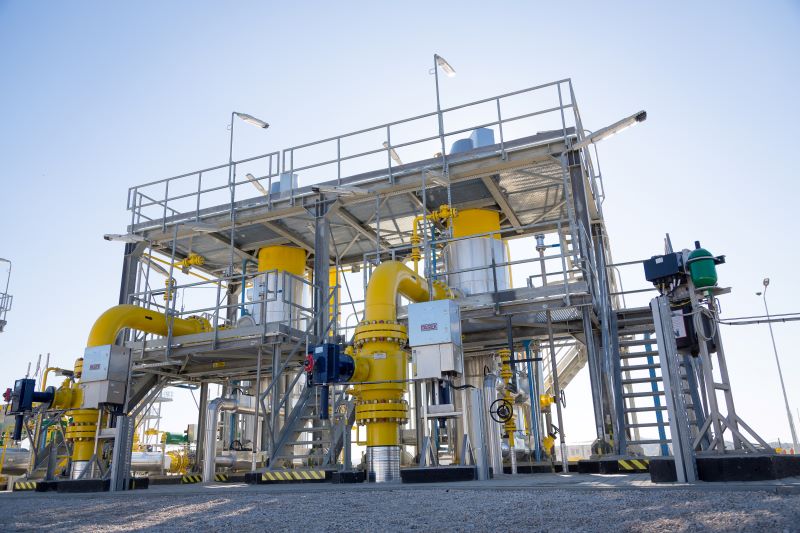CONTROL PROCESS S.A. w dn. 06.05.2025r. podpisała umowę z TAURON Ciepło Sp. z o.o. na realizację strategicznego zadania inwestycyjnego dla największego dostawcy ciepła sieciowego w konurbacji śląsko-dąbrowskiej. Kontrakt dotyczy budowy nowoczesnego układu kogeneracyjnego w Elektrociepłowni w Czechowicach-Dziedzicach (Bielsko-Północ EC2).
Zakres kontraktu obejmuje zaprojektowanie i budowę w formule „pod klucz” nowoczesnej elektrociepłowni, w zakres której wejdą: trzy agregaty kogeneracyjne, stacja uzdatniania wody, akumulator ciepła, infrastruktura pomocnicza oraz wszystkie niezbędne instalacje i obiekty budowlane. Instalacja zostanie zintegrowana z istniejącą infrastrukturą elektrociepłowni i umożliwi jednoczesne wytwarzanie energii elektrycznej oraz ciepła w skojarzeniu.
CONTROL PROCESS S.A. odpowiada za kompleksowe wykonanie inwestycji – od opracowania dokumentacji projektowej, przez dostawy, montaż i uruchomienie urządzeń, aż po przekazanie gotowego obiektu do eksploatacji.

Wartość realizowanej inwestycji wyniesie ponad 350 mln PLN brutto ( 287 milionów PLN netto), a jej zakończenie planowane jest na ostatni kwartał 2027 roku.
Spółka z Grupy CONTROL PROCESS z sukcesem zakończyła realizację zadania pn.: „Dostawa i zabudowa instalacji do sprężania gazu na terenie KGZ Kościan-Brońsko”.
Przedsięwzięcie inwestycyjne obejmowało kompleksowe zaprojektowanie, wykonanie oraz uruchomienie instalacji do sprężania gazu na terenie KGZ Kościan-Brońsko. W ramach zadania dostarczono, zmontowano i uruchomiono cztery kompletne zestawy sprężające gaz, oparte na sprężarkach gazu o łącznej mocy ok. 20,30 MW, wraz z chłodnicami gazu i silnika, tłumikami spalin, katalizatorami, instalacją odzysku ciepła ze spalin oraz systemem sterowania pracą agregatów sprężających.
Uruchomienie instalacji to wymierne korzyści: 10 mld m³ dodatkowego gazu ziemnego i kilkanaście lat dłuższej eksploatacji złóż.

CONTROL PROCESS S.A. przy udziale dostawcy Solar Turbines, zamontowała turbinę gazową Taurus 70 na inwestycji pn.: „Zagospodarowanie złoża Różańsko i budowa źródła kogeneracyjnego na potrzeby KRNiGZ Dębno”, realizowanej w ramach generalnego wykonawstwa.
Turbina gazowa, to zintegrowany napęd z pojedynczym wałem o przepływie osiowym. Powietrze zasysane jest do wlotu powietrza turbiny i sprężane przez wielostopniowy kompresor osiowy. Sprężone powietrze kierowane jest do komory spalania. Paliwo – gaz wytwarzany na terenie złoża Różańsko jest wtryskiwany do sprężonego powietrza w pierścieniowej komorze spalania.

Podczas rozruchu mieszanka paliwowo-powietrzna ulega zapłonowi. Gorący sprężony gaz z komory spalania rozpręża się i napędza sekcję turbiny silnika, obniżając ciśnienie i temperaturę, gdy opuszcza turbinę. W ten sposób energia zawarta w paliwie przekształcana jest w energię kinetyczną, pozwalającą napędzić wał turbiny gazowej.
W dniu 19.10.2022 spółka CONTROL PROCESS S.A. podpisała umowę z PGNiG S.A. na generalne wykonawstwo inwestycji pn.: „Zagospodarowanie złoża Różańsko i budowa źródła kogeneracyjnego na potrzeby KRNiGZ Dębno”.
Zadanie obejmuje m.in. rozbudowę stref produkcyjnych, budowę instalacji separacji wysokociśnieniowej, instalacji odsiarczania gazu i regeneracji aminy wraz z przewidzianym do tego celu budynkiem.
Ponadto inwestycja obejmuje zaprojektowanie i wykonanie instalacji kogeneracyjnej opartej o turbinę gazową i kocioł odzysknicowy.

Wartość inwestycji to ponad 340 mln PLN.
CONTROL PROCESS S.A. zakończyła w dn. 28.10.2021 r. realizację zamówienia pn.: „Budowa międzysystemowego gazociągu stanowiącego połączenie systemów przesyłowych Rzeczypospolitej Polskiej i Republiki Słowackiej – węzeł rozdzielczo-pomiarowy Strachocina”.
Zakres zamówienia obejmował w szczególności: budowę węzła rozdzielczo-pomiarowego wysokiego ciśnienia MOP= 8,4MPa. Spółka jako Generalny Wykonawca zrealizowała z sukcesem prace budowlano – montażowe w zakresie instalacji: technologicznych, budowlanych, sanitarnych, elektrycznych, AKPiA, ochrony obiektu, oprogramowania i uruchomienia systemu sterowania i wizualizacji, teletechnicznych oraz prace rozruchowe.

W dniu 18.05.2021 r. spółka CONTROL PROCESS S.A. jako generalny wykonawca podpisała umowę z Lwowskim Przedsiębiorstwem Komunalnym „Zielone Miasto” na budowę Zakładu Zagospodarowania Odpadów we Lwowie.
Zakres umowy obejmuje: zaprojektowanie, budowę i uruchomienie instalacji do sortowania i biosuszenia odpadów komunalnych. Wydajność instalacji wyniesie około 250 000 ton odpadów rocznie, zaś produktem finalnym będzie paliwo alternatywne, tzw. RDF.
Na terenie kompleksu sortowane będą surowce wtórne, frakcja organiczna będzie kompostowana, zaś z części użytkowej odpadów produkowane będzie paliwo alternatywne – RDF, które będzie wykorzystywane jako substytut dla paliw kopalnych w instalacjach energetycznych lub przemyśle cementowym.
Koncepcja projektu opiera się na idei maksymalnego zmniejszenia objętości resztkowej przetwarzanych odpadów. Zakłada się, że zastosowanie takich zasad technologicznych pozwoli na zmniejszenie o 65-70% ilości odpadów kierowanych na składowiska.

Wartość projektu to przeszło 150 mln PLN.
W dniu 21.04.2021 roku spółka z Grupy CONTROL PROCESS podpisała umowę z PGNiG S.A. na generalne wykonawstwo inwestycji pn.: „Dostawa i zabudowa instalacji do sprężania gazu na terenie KGZ Kościan-Brońsko”.
Przedmiotem umowy jest dostawa i zabudowa na terenie kopalni gazu ziemnego Kościan-Brońsko czterech nowych zestawów sprężających gaz ziemny. Zestawy sprężające przeznaczone będą do podnoszenia ciśnienia gazu ziemnego w celu osiągnięcia parametrów wymaganych w punkcie zdania do systemu przesyłowego.

Wartość inwestycji to ponad 135 mln zł.

